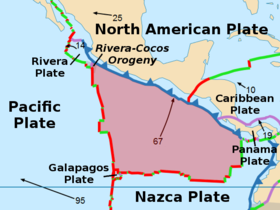Cocos Plate
| Cocos Plate | |
|---|---|
 |
|
| Type | Minor |
| Approximate area | 2,900,000 km2 |
| Movement1 | north-east |
| Speed1 | 67mm/year |
| Features | Cocos Island, Pacific Ocean |
| 1Relative to the African Plate | |
The Cocos Plate is an oceanic tectonic plate beneath the Pacific Ocean off the west coast of Central America, named for Cocos Island, which rides upon it.
The Cocos Plate was created by sea floor spreading along the East Pacific Rise and the Cocos Ridge, specifically in a complicated area geologists call the Cocos-Nazca spreading system. From the rise the plate is pushed eastward and pushed or dragged (perhaps both) under the less dense overriding Caribbean Plate, in the process called subduction. The subducted leading edge heats up and adds its water to the mantle above it. In the mantle layer called the asthenosphere, mantle rock melts to make magma, trapping superheated water under great pressure. As a result, to the northeast of the subducting edge lies the continuous arc of volcanos —also known as the Central America Volcanic Arc— stretching from Costa Rica to Guatemala, and a belt of earthquakes that extends farther north, into Mexico.
The northern boundary of the Cocos Plate is the Middle America Trench. The eastern boundary is a transform fault, the Panama Fracture Zone. The southern boundary is a mid-oceanic ridge, the Galapagos Rise. The western boundary is another mid-ocean ridge, the East Pacific Rise.
...
Wikipedia
